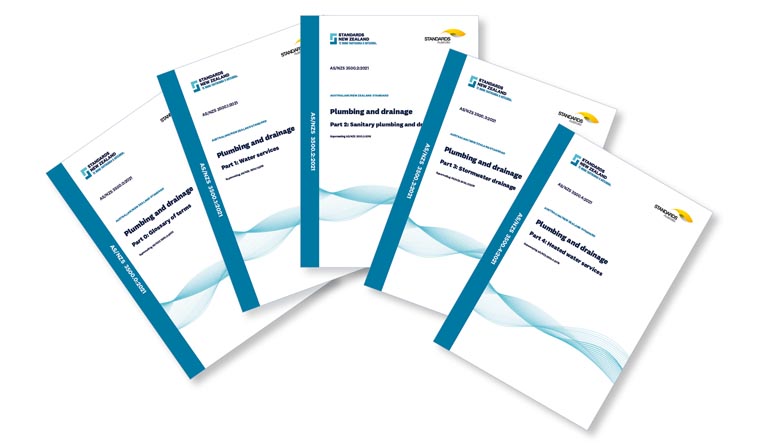Plumbing and drainage joint standards get an overhaul
New revisions to the AS/NZS 3500 Plumbing and drainage series of joint standards, every plumber, drainlayer, building designer, consenting officer, and other construction industry professional needs to know.

There’s change on the horizon and you need to know.
Calling all plumbers, drainlayers, building designers, consenting officers, and other construction industry professionals – revisions to the AS/NZS 3500 Plumbing and drainage series of standards were published on 28 May 2021. These revisions include some major changes and improvements to clarify some installation provisions and remove inconsistencies.
Joint standards support tradespeople across Australasia
The publication of the 2021 AS/NZS 3500 series follows a three-yearly revision project to continuously improve these standards. These standards play an integral part in setting out design and installation requirements for plumbing and drainage systems both in New Zealand and in Australia. They also supports the Trans-Tasman Mutual Recognition Arrangement, which provides for plumbers, and drainlayers who are registered in New Zealand to practise in Australia, and vice versa.
‘It puts everyone on the same page’, says Ross Wakefield, Senior Advisor Plumbing and Hydraulic Services with Building Performance, MBIE who have sponsored New Zealand’s participation in this project. ‘Users of the standards will have around 18 months to familiarise themselves with the changes, before these are proposed to be referenced as means of complying with the New Zealand Building Code, replacing 3500:2018 editions. There will be an opportunity to have your say beforehand as part of the next Building Code update consultation due in April 2022.’
Thank you to all those who have contributed to the revision of these standards, including through Standards Australia’s public consultation process in late 2020. Experts representing New Zealand’s input into this project have come from Master Plumbers New Zealand, Ministry of Business, Innovation and Employment (MBIE), Plastics NZ, Plumbers, Gasfitters and Drainlayers Board, Plumbing Distributors Association of New Zealand, and Water New Zealand.
Get your copy today
The AS/NZS 3500 series of standards are available on Standards New Zealand's website:
These can be viewed for free by licensed plumbers, gasfitters and drainlayers through their trade login on the Plumbers, Gasfitters and Drainlayers Boards website.
Trade login - Plumbers, Gasfitters and Drainlayers Board(external link)
In the meantime…
It is important to note that the previous AS/NZS 3500:2018 editions currently remain in force as means of complying with Building Code clauses E1, G12 and G13 (with some modifications).
Building Code updates will be consulted on in April 2022 to reference the latest AS/NZS 3500:2021 editions, with the latest editions intended to come into effect as a means of compliance in November 2022.
MBIE encourage you to stay up to date with proposed Building Code changes by subscribing to updates:
Subscribe to updates - Building performance(external link)
Note: The use of the AS/NZS 3500:2021 standards prior to being referenced as a means of compliance with the Building Code would need to be proposed as an alternative solution to the relevant building consent authority when applying for a building consent.
For more information on using alternative solutions for compliance with the Building Code, please refer to:
Alternative solutions for compliance with the Building Code - Building performance(external link)
So what’s different?
Major changes within the AS/NZS 3500:2021 Plumbing and drainage series include:
- The removal of specific product standard conformance requirements to avoid inconsistencies with the WaterMark scheme.
- Relocation of definitions into AS/NZS 3500:2021 Part 0 Glossary of terms for consistency across the series.
- Removal of cross-connection hazards and corresponding hazard ratings to avoid conflict between the Plumbing Code of Australia and New Zealand Building Code Acceptable Solution G12/AS1.
- Jointing requirements for plastics pipes have been clarified and expanded to allow different methods.
- Changes to the requirements for the marking of pipes in commercial buildings to assist in the better identification of pipework and avoid cross connections.
- Changes to the requirements for the installation of water services located in metal-framed walls.
- Changes to the connection requirements for sanitary drains at grade.
- The range of materials that can be used for wet wells has been expanded to encompass prefabricated wells.
- Design rainfall intensities for stormwater drainage systems are now expressed in terms of the Annual Exceedance Probability (AEP) values to reflect the practice of the Australian Bureau of Meteorology (BOM) and align with the performance requirements of the New Zealand Building Code clause E1 Surface water.
- Design rainfall intensities for stormwater drainage systems have been updated to show the latest values from the Australian Bureau of Meteorology (BOM) and New Zealand’s National Institute of Water and Atmospheric Research (NIWA).
- New Zealand rainfall maps have been replaced by Table E.1 showing 10 % AEP (10 years ARI) and 2 % AEP (50 years ARI) rainfall intensities for selected locations.
- The minimum separation distance between above-ground heated water services and electrical services has been reduced to align with the AS/NZS 3000 Wiring rules and AS/NZS 3500.1.
- Changes have been made to requirements for circulated heated water systems including water meters and entry points for heated water, thermal insulation for non-circulatory heated water piping, and maximum capacities of any dead leg from the branch offtake to its termination - to improve the amenity for users and reduce wastage of water and energy.
- Heated water temperature control provisions relating to maximum sanitary fixture delivery temperatures and solutions for control of delivery temperatures have been deleted to avoid conflict between the Plumbing Code of Australia and New Zealand Building Code Acceptable Solution G12/AS1.
